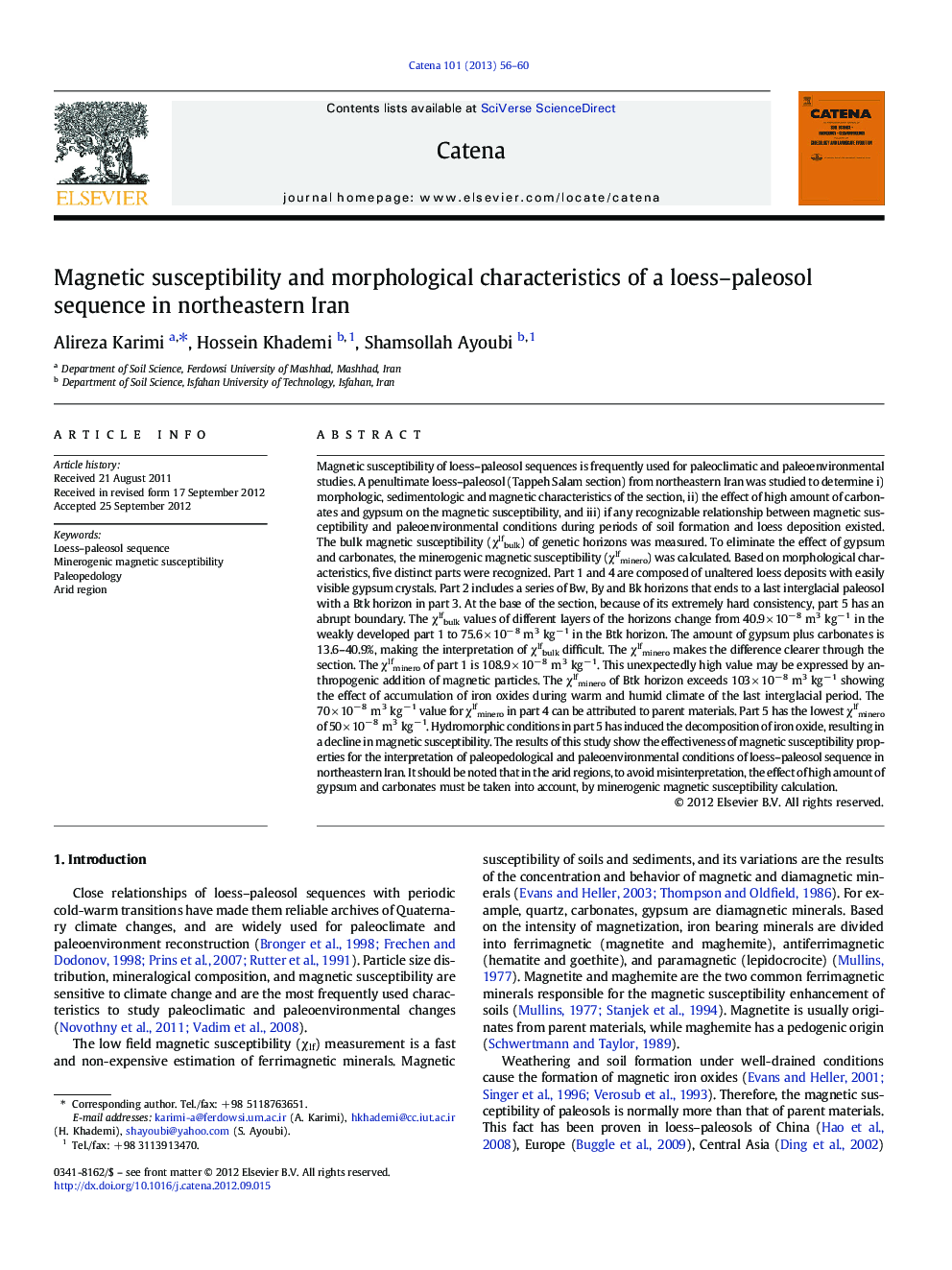| کد مقاله | کد نشریه | سال انتشار | مقاله انگلیسی | نسخه تمام متن |
|---|---|---|---|---|
| 4571612 | 1629251 | 2013 | 5 صفحه PDF | دانلود رایگان |

Magnetic susceptibility of loess–paleosol sequences is frequently used for paleoclimatic and paleoenvironmental studies. A penultimate loess–paleosol (Tappeh Salam section) from northeastern Iran was studied to determine i) morphologic, sedimentologic and magnetic characteristics of the section, ii) the effect of high amount of carbonates and gypsum on the magnetic susceptibility, and iii) if any recognizable relationship between magnetic susceptibility and paleoenvironmental conditions during periods of soil formation and loess deposition existed. The bulk magnetic susceptibility (χlfbulk) of genetic horizons was measured. To eliminate the effect of gypsum and carbonates, the minerogenic magnetic susceptibility (χlfminero) was calculated. Based on morphological characteristics, five distinct parts were recognized. Part 1 and 4 are composed of unaltered loess deposits with easily visible gypsum crystals. Part 2 includes a series of Bw, By and Bk horizons that ends to a last interglacial paleosol with a Btk horizon in part 3. At the base of the section, because of its extremely hard consistency, part 5 has an abrupt boundary. The χlfbulk values of different layers of the horizons change from 40.9 × 10− 8 m3 kg− 1 in the weakly developed part 1 to 75.6 × 10− 8 m3 kg− 1 in the Btk horizon. The amount of gypsum plus carbonates is 13.6–40.9%, making the interpretation of χlfbulk difficult. The χlfminero makes the difference clearer through the section. The χlfminero of part 1 is 108.9 × 10− 8 m3 kg− 1. This unexpectedly high value may be expressed by anthropogenic addition of magnetic particles. The χlfminero of Btk horizon exceeds 103 × 10− 8 m3 kg− 1 showing the effect of accumulation of iron oxides during warm and humid climate of the last interglacial period. The 70 × 10− 8 m3 kg− 1 value for χlfminero in part 4 can be attributed to parent materials. Part 5 has the lowest χlfminero of 50 × 10− 8 m3 kg− 1. Hydromorphic conditions in part 5 has induced the decomposition of iron oxide, resulting in a decline in magnetic susceptibility. The results of this study show the effectiveness of magnetic susceptibility properties for the interpretation of paleopedological and paleoenvironmental conditions of loess–paleosol sequence in northeastern Iran. It should be noted that in the arid regions, to avoid misinterpretation, the effect of high amount of gypsum and carbonates must be taken into account, by minerogenic magnetic susceptibility calculation.
► Magnetic susceptibility of a loess–paleosol sequence in northeastern Iran was studied.
► Bulk and minerogenic magnetic susceptibility (χlfminero and χlfminero) were measured.
► High amount of gypsum plus carbonates make the interpretation of χlfbulk difficult.
► Paleosols has the most χlfminero and χlfminero values.
► The χlfminero makes the difference more clear through the section.
Journal: CATENA - Volume 101, February 2013, Pages 56–60